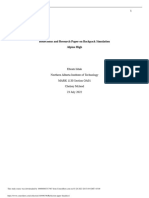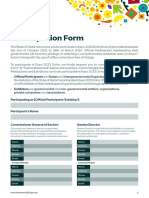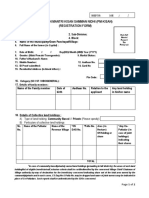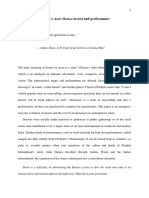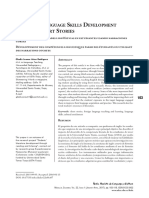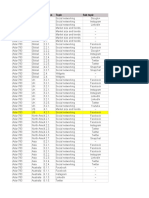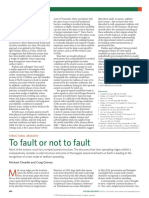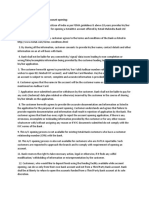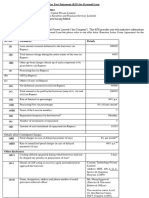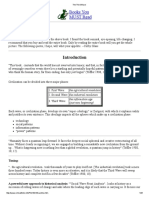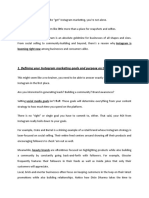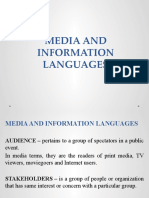I
NTERNATIONAL
J
OURNAL OF
M
ULTIDISCIPLINARY
E
DUCATIONAL
R
ESEARCH
ISSN: 2277-7881; I
MPACT
F
ACTOR
– 6.014; IC V
ALUE
:5.16; ISI V
ALUE
:2.286 V
OLUME
8, I
SSUE
9(6), S
EPTEMBER
2019
www.ijmer.in
27 MEDIA DEPENDENCY AND BEHAVIOUR ON SOCIAL MEDIA #DEMONETISATION NARRATIVES Dr.K.S.Krithika
Assistant Professor Department of Visual Communication Pondicherry University Community College Pondicherry, India
Abstract
Social Media, of late, is witness to a phenomenon of dictated behaviour as a result of a profusion of politically articulated content in the mainstream media. In conditions of social change and conflict, according to the dependency theory, the potential effects of media on the audience are greater. This politically mediated/motivated behaviour was observed in the behaviours of the users of WhatsApp, when the Government of India implemented demonetisation of currencies of Rs. 500 and Rs.1000 denominations. While screening the communication exchanges on the Whatsapp platform, between the supporters and critics of demonetisation, a homogeneous pattern could be discerned to be emerging among the supporters of the economic policy, which appeared to be, largely, motivated by the dominant political discourse streamed through the mainstream media. A faithful replication of the information on the mainstream media was observed in WhatsApp. A certain hegemonic insolence was discernible in the various WhatsApp groups taken up for study. These WhatsApp texts are deconstructed to find the dominant ideology one is part of.
Key words
: Demonetisation, Social Media Behaviour, Media Dependency, Dominant Ideology, Free Expression, Etc.
Introduction
“…. Agents (Social) draw from structures to involve in social interactions and by way contribute to the reproduction of institutions and structures. Structure has no independent existence without the knowledge that agents have about their day-to-day activity.” (Giddens, 1984). The social media are platforms for expression of the public opinion without any restriction or monitoring. But that is not the case now. The social media posts are manipulated and dominated by various forces like the cyber troops. “Cyber troops are teams employed by government, military or political-party to manipulate the public opinion in the social media. Strategic communication firms take contracts from governments for social media campaigns to influence public opinion over social media networks. According to Bradshaw and Howard’s study, organized social media manipulation reports came up in 2010 and by 2017, 28 countries had similar organizations.” (Bradshaw and Howard, 2017). After the act of demonetisation on 8 November 2016, there were hordes of discussion on demonetisation and its effects on the nation and its people. Media at large has given a wide coverage to the aftereffects of demonetisation and the Prime Minister Narendra Modi’s intent behind such a significant step has come under intense scrutiny. The local





I
NTERNATIONAL
J
OURNAL OF
M
ULTIDISCIPLINARY
E
DUCATIONAL
R
ESEARCH
ISSN: 2277-7881; I
MPACT
F
ACTOR
– 6.014; IC V
ALUE
:5.16; ISI V
ALUE
:2.286 V
OLUME
8, I
SSUE
9(6), S
EPTEMBER
2019
www.ijmer.in
28
and international media was split wide open into two opposing camps: those who held the economic move was a much-needed one, to rid the country of corruption, fake currency, etc., and those who vehemently opposed the same on the grounds that this was a shoddily planned and executed policy intervention that had very poor, if any, economic rationale, at all. And the ruling government, the pro government organisations, media and individuals in support of the note ban adopted a uniform rhetorical method in handling the situation. They cited the endeavour as a cleaning process for the welfare of the country. Interestingly, the argument that our soldiers were dying in the borders and in Kashmir was bandied about, while everyone who questioned or opposed demonetisation was being branded as anti-national in the following days of the announcement of demonetisation, both in pro-government mainstream media and social media handles. Many Pro Government media news carried the political messages of the Prime Minister and other politicians of the ruling party. And the political narrative of seeing demonetisation as ‘s
huddhi yagna’
(ritual cleansing) was carried forward by ideologues who religiously parroted their leader’s message by re-tweeting them verbatim. This trend showed a very visible pattern of organized social media manipulation during the situation when the whole nation was looking out in anguish for some valid information. The deluge of pro-demonetisation information flow is so copious and thick that it would be a gargantuan task to delineate the same, and, thus would not be attempted by the author. In India, “cyber troops recruit citizens to disseminate political ideologies” (Kohlil, 2013). “Since these citizens are not associated formally with the government or any political party, their “independent voices” are used to publicize messages from an ostensibly unbiased outlook. The study has found evidences of Bharatiya Janata Party (BJP) recruiting citizens in cyber troops to propagate political ideologies.” (Bradshaw and Howard, 2017). The effective use of social media for campaigning by the Bharatiya Janata Party, the ruling party since 2014, itself is a subject of study. The social media was garnered to attract the young voters. The drastic change in the image of the then Prime Ministerial candidate Modi from a Right wing politician to an influential leader was majorly achieved through the strategic use of mainstream media and social media by roping in a team of advertising legends including Piyush Pandey from Ogilvy & Mather, Prasoon Joshi from McCann Worldgroup and Sam Balsara from Madison World. Reaching the voters through text messages of recorded voice of Modi was new to political campaigning in India. It also entered the social media platforms such as Facebook, YouTube and Twitter and Modi has about four million Twitter followers alongside the impactful advertising and branding campaign. So, there is a clearly planned stratagem being employed by political parties to tap the potential of the social media, WhatsApp in particular, to reach and manipulate the everyday interactions of the people. This paper does not directly link the contents of the WhatsApp messages with the content of the cyber troops. It tries to find similarities between the mainstream media content and the WhatsApp discourse/narratives, by way linking it to the mass generated content that leads to the absence of original expression. The political agenda of criticising the voices of dissent seemed to have been truly established in the pro-government mainstream media. The narratives that were
I
NTERNATIONAL
J
OURNAL OF
M
ULTIDISCIPLINARY
E
DUCATIONAL
R
ESEARCH
ISSN: 2277-7881; I
MPACT
F
ACTOR
– 6.014; IC V
ALUE
:5.16; ISI V
ALUE
:2.286 V
OLUME
8, I
SSUE
9(6), S
EPTEMBER
2019
www.ijmer.in
29
predominant in the mainstream media instantly percolated into the social Media. The social media users with pro-government ideologies used the same arguments about demonetisation to silence the people in the social media groups like Facebook and WhatsApp. While doing a content analysis of the interactions on social media, a behavioural pattern emerged thereof, similar to the predominant trend in the mainstream media. This paper tries to trace the interactions of the members of two WhatsApp groups from 8 November, 2016 to September 2017, a consistent period of ten months after demonetising of higher value notes of Rs.1000/- and Rs.500/- in India. There appeared to be a desperation among the government functionaries and pro-government ideologues, to defend the act of demonetisation in the mainstream media with an evident idiosyncratic bias. The social media took the cue as well and a pattern of rabid arrogance was emerging, prevalently, among all the defenders in the media. Voices of dissent were being silenced, vehemently. This trend is palatable with the mainstream media, which has no instant feedback. However, it is inexplicable that in a markedly interactive social medium, such as the WhatsApp group, where even the usually reticent observers turn active communicators, this cowing down could be experienced. Owing to an unusually aggressive posturing of the rightists, emboldened by the partisan reporting in the mainstream media the other members of the groups chose to remain silent. This pattern of social media behaviour induced by the mainstream media behaviour and political suppression in the country is the subject of discussion in this paper. The narrative in the mainstream media revolving around the demonetisation has been extremely guarded while analysing the possible negative fall-out of the economic intervention. There appears to be a vast gap between what was being reported in favour of demonetisation and what was actually being experienced at the ground-level. This paper looks at the dependence, if any, of WhatsApp interactions on mainstream media discourse. And also throws light on the intentional and unintentional lack of analysis and judgement on the part of the WhatsApp users.
Review of Literature
According to the study done by Bradshaw and Howard, “the British Army, in January 2015 announced that in this information age, its 77
th
Brigade would concentrate on fighting their enemies by controlling the narrative on social networks like Facebook and Twitter” (Solon, 2015). “This unit would concentrate on shaping public behaviour
through the dynamic narratives in the social media to contest the political hoopla dispersed by terrorist organisations. Many other countries like the United Kingdom are allocating funds for troops to influence online political discourse” (Bradshaw and Howard, 2017). “From the samples collected for the study by Howard and Bradshaw, Cyber troops in almost all the sampled countries comment on users’ posts on social media networks. The nature of engagement vary across samples. Some cyber troops post only positive messages that strengthen the government’s political ideology and some post negative messages including verbal mistreatment, harassment and “trolling” against users
I
NTERNATIONAL
J
OURNAL OF
M
ULTIDISCIPLINARY
E
DUCATIONAL
R
ESEARCH
ISSN: 2277-7881; I
MPACT
F
ACTOR
– 6.014; IC V
ALUE
:5.16; ISI V
ALUE
:2.286 V
OLUME
8, I
SSUE
9(6), S
EPTEMBER
2019
www.ijmer.in
30
who express contempt for the ruling party in the social media. In many countries, according to their evidences, cyber troops do negative interactions with political dissenters.” (Bradshaw, Howard, 2017). “Hashtag poisoning in twitter is found in Saudi Arabia, where the cyber troop junks the trending hashtags, by way disrupt criticism or any other undesirable dialogues in the flooding disparate tweets” (Freedom House, 2013). “Cyber troops often mix positive, negative and neutral posts in social media as informed by a member of the alleged “50 Cent party” (presumed that the internet commentators were paid 50 cents by the government, for each comment they post online.) The study found that the troops adopted a general strategy of posting sensitive comments online to create/raise the temper of the common people against the commentator and thus distracting criticism of the dissenters from the government or political issue that is contended originally”. (Weiwei, 2012). “In Azerbaijan, individuals who criticize governments are frequently targeted on social media platforms. The Azerbaijan’s IRELI youth, as per Geybulla’s study, are known to posting offensive comments on social media. The youngsters of the cyber troop generally discourage regular internet users from involving in political discussions online and from supporting political protests” (Pearce & Kendzior, 2012). “The Kremlin-aligned Nashi Youth Movement leaders, in Russia, have circulated a list declaring some of the human right activists as “the vilest of enemies” (Elder, 2012). “Other than social media, the cyber troops are active in varied online platforms and applications like mobile applications, government web pages and blogs, which are the general media used by the government to spread political propaganda or silence voices of dissent. Occasionally, these online platforms allow the cyber troops or other
citizens to share, retweet or like government-sponsored posts” (Benedictus, 2016). “Somos+ is a website started by the government of Ecuador to inspect and reply to social media users, who criticize the government. This has provided a chance for the pro-government factions to jointly target the political dissenters” (Morla, 2015). “There are cyber troop teams that spread content created by them. They create blog posts, You Tube videos, fake news stories, pictures or memes and comment on posts to favour the government’s political schema” (Bradshaw, 2017). “In China, the cyber troops function under a public administration. It has many local offices that organize the activities of their regional offices and offices across the country to create and circulate a shared narratives, all over the country” (weiwei, 2012).
“Some cyber troops in some democracies are doing studying the effects of network and finding out effective ways to spread and intensify the impact of the message across social media” (Bradshaw and Howard, 2017).
Objectives
To understand whether there is any originality/ analytical overview in the content written by WhatsApp group members.
To understand the dependency of the WhatsApp group members on mainstream media for content/ideas.
To study the amount of individual targeting involved to dissuade political dissidents.



